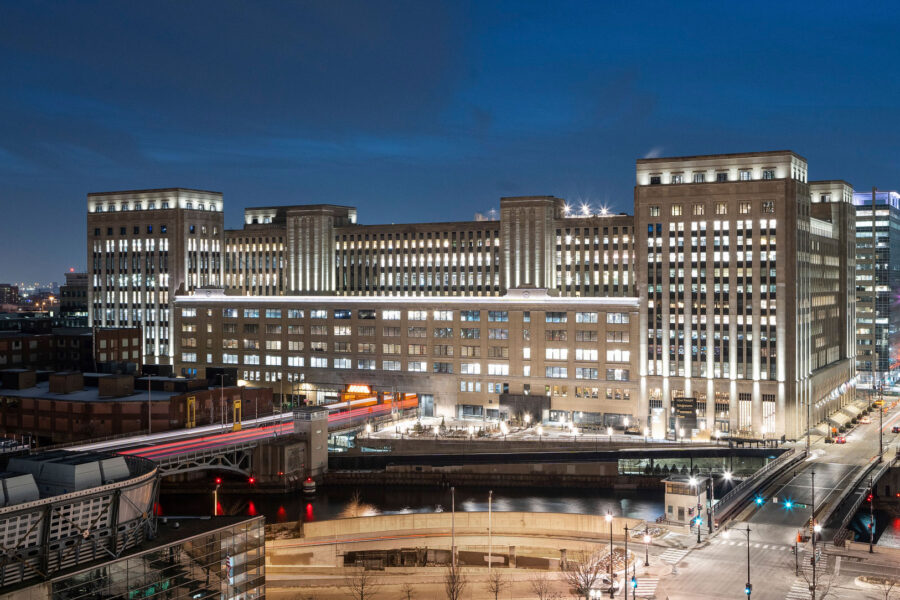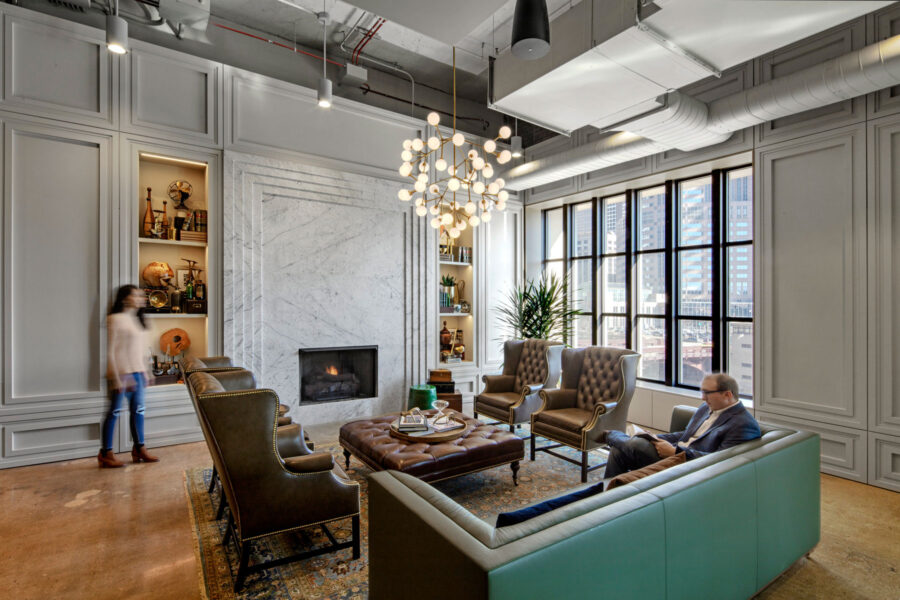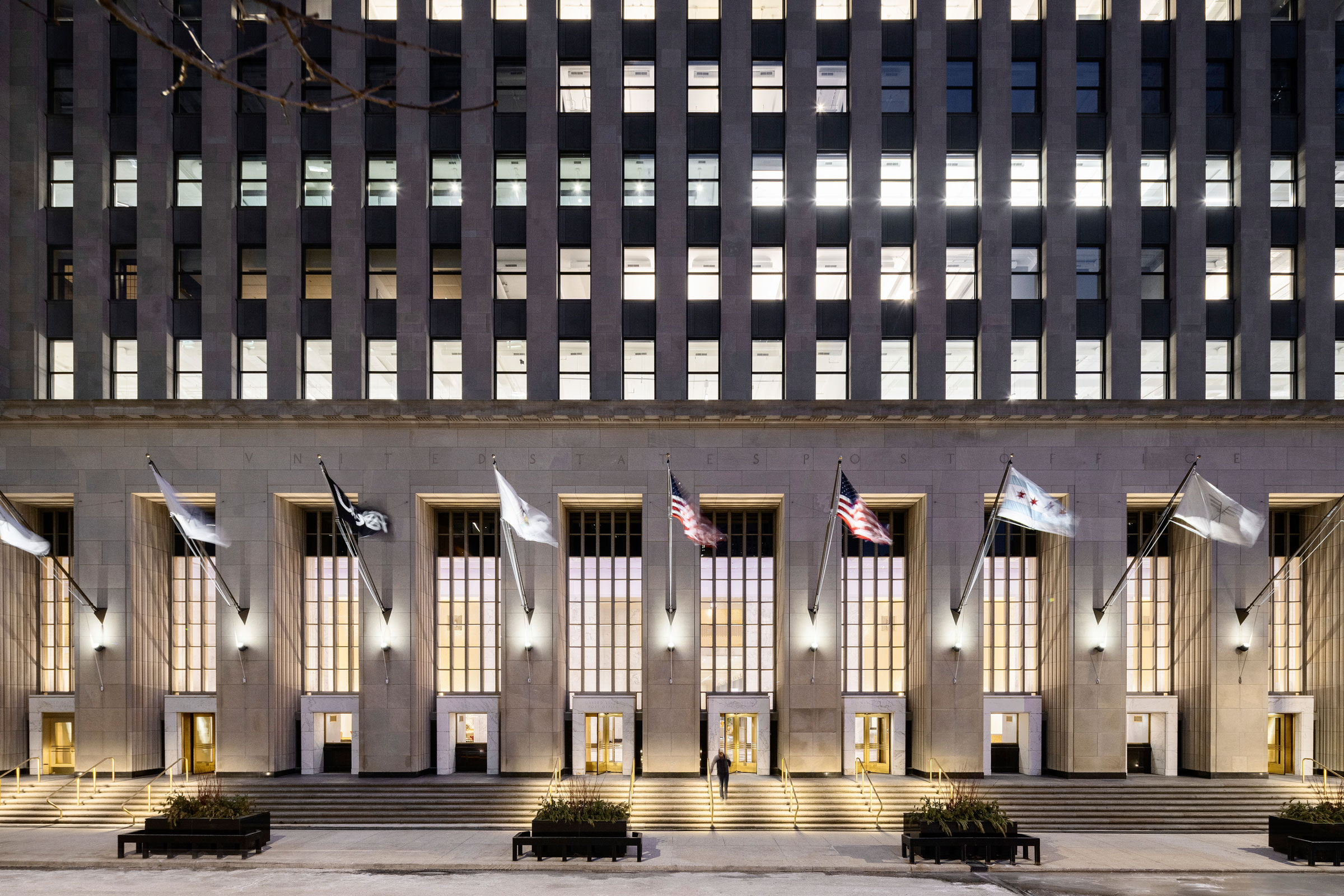Story at a glance:
- Natural stone continues to be a celebrated building material, inside and out.
- The existing Indiana limestone on the facade of the Old Chicago Post Office was cleaned, and new stone was installed to match the existing stone that was there for almost 100 years.
The Old Chicago Post Office was a lost cause. That’s how it felt, at least, for nearly two decades as the Art Deco behemoth on the Chicago River sat vacant.
“The biggest challenge was probably getting the project off the ground,” says Gensler’s Ashley Rogow, project architect for The Post Office and an adaptive reuse leader at the global architecture firm.
The building—clad in incredible Indiana Limestone—had been abandoned since the late ’90s, increasingly giving developers, investors, and even the city of Chicago a bad impression, Rogow says. Much was written in the news about the massive empty building—2.8 million square feet, to be exact—and much of it was not nice. “It had this reputation that nothing would ever happen to it,” Rogow says.
The old building, circa 1921, was designed by Graham, Anderson, Probst & White. When Gensler got involved nearly 100 years later to save the giant, she says there was a lot of “eyebrow raising,” like, “Is this really going to happen?” It was Rogow’s first project with Gensler, working as an architectural designer primarily on the core and shell as well as some of the interior spaces and public spaces on the first floor from the beginning conceptual design. The project was completed in 2020 and ultimately achieved LEED Gold. It’s now home to some high-profile tenants, including Uber.
Repairing the Exterior

Photo by Serhii Chrucky
The building’s facade is made out of Indiana limestone, a classic for this style of architecture, Rogow says, but some of the pieces were starting to fall off after so many years. “When we were looking at restoring it, it was very important to us to replace as little as possible so we could try to preserve the natural stone and materials that were already within the project,” she says.
Gensler began replacing broken pieces and got to work cleaning the stone, and they were careful to make sure any new stone matched, getting sample after sample of different limestone colors. They worked with Regal Stone, a local fabricator in Chicago, which Polycor supplied the raw material to. Based in Canada, Polycor has quarries across North America and Europe.
“One of the benefits of the Indiana limestone that was on that project is that when you have to do these renovations decades later, Indiana limestone is such a consistent material that the stone that comes out of the ground today will basically look like the stone that came out of the ground 100 years ago,” says Stephen DiRaffaele, an Indiana limestone expert who focuses largely on building cladding. DiRaffaele is a LEED Green Associate and architectural sales representative for Polycor. “You can get a very consistent look of material. Really nothing compares to that specific species of natural stone when it comes to its consistency.”
The Sustainability of Stone

The Old Chicago Post Office sat vacant for many years before Gensler started a large restoration project. Photo by Serhii Chrucky
Rogow says natural stone is also great for high traffic interiors because it’s so resilient. Plus, it’s more environmentally friendly than many alternatives. “I love it as a material in a vacuum. It’s an incredibly sustainable material,” she says. “It’s going to last longer than concrete or glass. It doesn’t corrode like metals. It’s recyclable and low maintenance. It doesn’t release VOCs, and it takes a lot less water to produce.”
One important thing to note, though, is where it’s coming from. Gensler always aims to source from as near as possible. “If you have to bring it in from very far away, all of that goodwill can go out the window because now you’ve used a lot of resources to move a very heavy material a long distance. When we’re talking about sustainable stone, we’re really looking for stone that’s maybe within 500 miles of the site,” she says.
She says some people think a lot of natural stone has to come from Europe, but it simply doesn’t. “We have a lot of really beautiful natural stone in the United States and North America. You can find great stone that is local, in which case it becomes a very, very sustainable material.”
DiRaffaele says today’s stone quarries follow very responsible sourcing practices, too, to minimize the ecological impact to the earth. “It’s a very simple process; you just need brute strength. It’s ready-made, and it’s also recyclable. It comes from the earth, and it goes back to the earth. Unlike strip mining you’re not damaging the environment. A lot of quarries are reclaimed after their usefulness has expired and natural water fills them; they become lakes.”
You can also finish natural stone in ways that can extend the life of the material, Rogow says. “You can make it more weather-resistant or resistant to wear and tear. You can make it very non-slip to use outside.”
Other Ways to Use Natural Stone

More design teams are also incorporating natural stone in their interiors in part because it’s environmentally friendly. Photo by Eric Laignel
Today Gensler considers natural stone most often for interiors. Even inside the Old Chicago Post Office you’ll find plentiful marble and granite—including a pink granite that the Gensler design team spent a lot of time matching.
Rogow says natural stone can make a big impact with color. “One of the really nice things about stone is all the varieties of ways it can be finished,” she says. “There’s this thinking that natural stone has to look very heavy. You can use it to make spaces that are dark and moody and look very stately, but you can also find stone that’s very playful in color. It can create spaces that feel very light.”
The diverse range of colors and patterns mean seemingly limitless design potential. Natural stone can even be used as a feature wall or backsplash. Gensler has used it for both, including recently as a wall in a restroom. “The design impact is huge. It makes the space feel very luxurious,” Rogow says.
DiRaffaele says more design teams are also incorporating natural stone in their interiors in part because it’s environmentally friendly. “It doesn’t emit any VOCs. We see natural stone in the interior environment all the time.” Beyond feature walls, it’s also showing up in fireplaces, swimming pools, and office desks.
On the exterior some architecture teams are turning to options like Ultra-Thin Natural Stone Slabs or honeycomb panel systems to reduce the weight of natural stone by up to 80%, DiRaffaele says.
He says natural stone is held in a very high regard for good cause, as it’s a premier building material. “It really reflects the unique character or grandeur of a project. The variations in natural stone are so broad in range of color and pattern and texture that it’s visually interesting, and it really is impossible to replicate. When an architect is looking to put their mark on a building nothing comes close to natural stone. It’s a very versatile material.”

